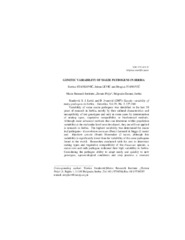Приказ основних података о документу
Genetic variability of maize pathogens in Serbia
Genetička varijabilnost patogena kukuruza u Srbiji
| dc.creator | Stanković, Slavica | |
| dc.creator | Lević, Jelena | |
| dc.creator | Ivanović, Dragica | |
| dc.date.accessioned | 2019-05-16T12:07:14Z | |
| dc.date.available | 2019-05-16T12:07:14Z | |
| dc.date.issued | 2007 | |
| dc.identifier.issn | 0534-0012 | |
| dc.identifier.uri | http://rik.mrizp.rs/handle/123456789/152 | |
| dc.description.abstract | Variability of some maize pathogens was identified in the last 50 years of research in Serbia, mostly by their cultural characteristics and susceptibility of test genotypes and only in some cases by determination of mating types, vegetative compatibility or biochemical methods. Although more advanced methods that can determine within population variability at the molecular level were developed, they are still not applied in research in Serbia. The highest variability was determined for maize leaf pathogens - Exserohilum turcicum (Pass.) Leonard & Suggs (2 races) and Bipolaris zeicola (Stout) Shoemaker (2 races), although this variability is significantly lower than the variability of the same pathogens found in the world. Researches conducted with the aim to determine mating types and vegetative compatibility of the Fusarium species, a maize root and stalk pathogen, indicated their high variability in Serbia. Considering the pathogen ability to adapt easily and quickly to new genotypes, agro-ecological conditions and crop practice, a constant surveillance of parasite divergence and epidemiology is necessary in order to avoid detrimental consequences on maize yield and quality. | en |
| dc.description.abstract | U Srbiji je u poslednjih pedeset godina istraživanja identifikovana varijabilnost nekih patogena kukuruza, i to najčešće na osnovu njihovih odgajivačkih odlika i osetljivosti test genotipova, a samo u nekim slučajevima na osnovu određivanja mating tipova, vegetativne kompatibilnosti ili biohemijskih metoda. Suprotno tome, u svetu se sve više primenjuju metode kojima se utvrđuje varijabilnost unutar jedne populacije na molekularnom nivou. Najveća varijabilnost utvrđena je kod patogena lista kukuruza - Exserohilum turcicum (Pass.) Leonard & Suggs (2 rase) i Bipolaris zeicola (Stout) Shoemaker (2 rase), mada je ona značajno manja u odnosu na varijabilnost istih patogena u svetu. Rezultati istraživanja u cilju određivanja mating tipova i vegetativne kompatibilnosti vrsta roda Fusarium, patogena korena i stabla kukuruza, ukazali su na njihovu veliku varijabilnost u Srbiji. S obzirom na svojstvo patogena da se lako i brzo prilagođavaju novim genotipovima, agroekološkim uslovima i agrotehničkim merama, neophodno je stalno praćenje divergentnosti i epidemiologije parazita, da bi se izbegle veće posledice po prinos i kvalitet prinosa kukuruza. | sr |
| dc.publisher | Društvo genetičara Srbije, Beograd | |
| dc.rights | openAccess | |
| dc.rights.uri | https://creativecommons.org/licenses/by-nc-nd/4.0/ | |
| dc.source | Genetika | |
| dc.subject | maize | en |
| dc.subject | variability | en |
| dc.subject | VCG | en |
| dc.subject | mating population | en |
| dc.subject | races | en |
| dc.subject | pathogen | en |
| dc.title | Genetic variability of maize pathogens in Serbia | en |
| dc.title | Genetička varijabilnost patogena kukuruza u Srbiji | sr |
| dc.type | article | |
| dc.rights.license | BY-NC-ND | |
| dc.citation.volume | 39 | |
| dc.citation.issue | 2 | |
| dc.citation.spage | 227 | |
| dc.citation.epage | 240 | |
| dc.citation.other | 39(2): 227-240 | |
| dc.identifier.doi | 10.2298/GENSR0702227S | |
| dc.identifier.fulltext | http://rik.mrizp.rs//bitstream/id/2094/150.pdf | |
| dc.type.version | publishedVersion |


